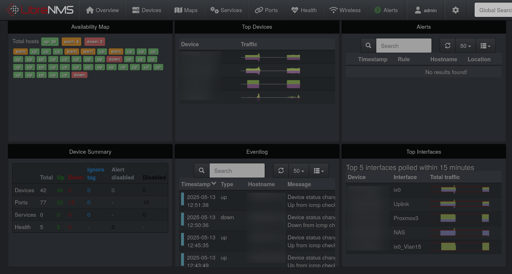StarkZarn
- 6 Posts
- 32 Comments

 5·7 days ago
5·7 days agoHey good for you, that’s awesome! My home network is also dual stacked.
You’re right about the apples to oranges comparison, but it’s not so wildly off, because the commentary is on adoption of new standards, regardless of bolt-on “fixes.” Unauthenticated SNMP went through three revisions prior to adding authentication and encryption support.

 5·7 days ago
5·7 days agoAnd IPv6 was codified in RFCs and first addresses issued in 1999 but look where we are now. I’d bet your corporate network doesn’t use IPv6 still. It’s unfortunate, but sometimes the wheels of change are slow.

 5·7 days ago
5·7 days agoNagios is a premium offering. They have some open source components, but the software model is absolutely not built around the spirit of GPL.
Zabbix is the obvious alternative in my mind, and it is AGPLv3, so absolutely in the same spirit as the LibreNMS license. It’s a slightly different tool though, and less network-specific. Having used both, I prefer LibreNMS for specifically network monitoring, it’s laid out to cater more to an ISP-type entity running it, and I like that. Zabbix still gets my wholehearted stamp of approval though.

 5·7 days ago
5·7 days agoUpdated the post to reflect your feedback here. Thank you!

 7·7 days ago
7·7 days agoYou are absolutely correct, thank you. Sadly a bunch of devices still don’t support it, even in 2025 (like my microtik switch) for example. I will absolutely add a note about that though, thank you!

 3·7 days ago
3·7 days agoI absolutely have and used it for a while before landing on opensuse microos primarily. I absolutely see the benefit and enjoyed the git-centric nature, keeping flakes in repos with a flavor for each machine. What I didn’t enjoy, however, was the seemingly poor documentation. Quite frankly too, the drama surrounding the community doesn’t inspire confidence either. I decided I ought to try out guix but haven’t gotten to it yet. I do actually still have one nixos VM that hosts some services for me and is built entirely on the concept of the impermanence flake. That was pretty cool.

 2·7 days ago
2·7 days agoExcellent! Let me know if there are specific things you’d like to hear about.

 2·7 days ago
2·7 days agoAbsolutely! I’d happily take any comments you have from running it in an enterprise setting, if you care to share.

 2·24 days ago
2·24 days agoI would love to if I had them! Haha. I’m working on the dashboard right now, which will be part two.
I don’t have a great answer on the IOPS requirement, but I imagine it’s less than something based on elasticsearch/open search based on the reindexing. I’ll try and benchmark it if possible.

 1·24 days ago
1·24 days agoGreat question, I’ve asked myself the same thing.
First, in my opinion they serve to achieve different things. While openwrt is a firewall, it’d a simple zone based firewall and it designed primarily as router firmware, not firewall software.
Opnsense is BSD based, openwrt is Linux based. Those both haves pros and cons. BSD has serious pedigree in the networking world. Juniper switches are still based on BSD even. Openwrt gets the Linux traffic shaping goodies like cake though.
I chose openwrt because it’s more suited to my environment, where I have 10 VLANs, a 10G fiber core, and want IDS/IPS. Openwrt is meant to be lighter weight, but is less feature-full.

 4·26 days ago
4·26 days agoIsn’t it the best? Somehow all the big log and aggregation stacks are java… Elk, graylog, wazuh…

 2·26 days ago
2·26 days ago🤘

 5·27 days ago
5·27 days agoCertainly! Feel free to comment on any hardships, if I notice a glaring omission or something I’m happy to fix it. This is also a pretty new setup for me, so I’m still tweaking and working through what will become part 2 here in Grafana, currently.

 2·27 days ago
2·27 days agoHey, the journey is the destination sometimes. Glad you liked it!

 6·28 days ago
6·28 days agoThere’s no mobile app, but the web app front end is a PWA, so you can select “install” from the page in a WebKit browser and get what is effectively a mobile app.

 2·29 days ago
2·29 days agoAwesome! Thanks for the banter. It’s easy to get stuck in your own echo chamber working IT every day, so it’s nice to have these kinds of questions. Feel free to drop anything into comments too, maybe other readers will benefit too!

 1·30 days ago
1·30 days agoNo worries, and I’ll accept criticism too, that’s how you improve.
Anyway, this is effectively giving you tailscale, a remote access mesh VPN solution, but with total control and ownership of the control plane server, instead of relying on the opaque tailscale owned and controlled infra. I touched on it briefly again the ‘DERP Config’ section of part 2: https://roguesecurity.dev/blog/headscale-quadlet-part2#DERP Config

 1·1 month ago
1·1 month agoPart 2 is live! https://roguesecurity.dev/blog/headscale-quadlet-part2


The OIDC settings in the Authelia config reference were the most nebulous to me, but they weren’t entirely stumping. The hard part was interpreting whether my errors stemmed from an issue on the client application side or on the Authelia side.
I would imagine you could likely extend the config snippets from my post to work in your situation with a few tweaks. The big lift, the OIDC provider is covered, so I’d be curious to hear what else you have to tweak!